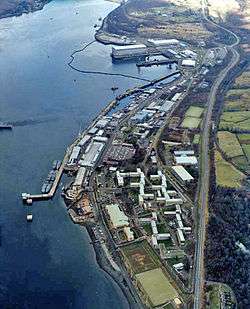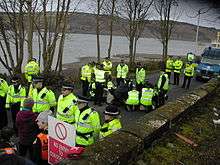HMNB Clyde
Her Majesty's Naval Base, Clyde (HMNB Clyde; also HMS Neptune), primarily sited at Faslane on the Gare Loch, is one of three operating bases in the United Kingdom for the Royal Navy (the others being HMNB Devonport and HMNB Portsmouth). It is the navy's headquarters in Scotland and is best known as the home of Britain's nuclear weapons, in the form of nuclear submarines armed with Trident missiles.
| HMNB Clyde | |
|---|---|
| Gare Loch, Argyll and Bute, Scotland | |
 View of HMNB Clyde | |
| Type | Military base |
| Site information | |
| Controlled by | Royal Navy |
| Website | www |
| Site history | |
| In use | 1964–present |
| Garrison information | |
| Current commander | Commodore Donald Doull[1] |
History
Faslane was first constructed and used as a base in the Second World War. During the 1960s, the British Government began negotiating the Polaris Sales Agreement with the United States regarding the purchase of a Polaris missile system to fire British-built nuclear weapons from five specially constructed submarines. In the end, only four were constructed; HMS Resolution, HMS Repulse, HMS Renown and HMS Revenge. These four submarines were permanently based at Faslane.[2]
Faslane itself was chosen to host these vessels at the height of the Cold War because of its geographic position, which forms a bastion on the relatively secluded but deep and easily navigable Gare Loch and Firth of Clyde on the west coast of Scotland. This position provides for rapid and stealthy access through the North Channel to the submarine patrolling areas in the North Atlantic, through the GIUK gap to the Norwegian Sea. At the time it was chosen, the location was also close to the American SSBN base at Holy Loch, which operated 1961–1992. One boat was always on patrol at any given time.[3]
In 1971 the base was home to the 3rd Submarine Squadron of Nuclear Fleet and Diesel Patrol Submarines, "the fighters", and the 10th Submarine Squadron consisting of the four Polaris submarines, "the bombers".[4]
In Command
Based vessels and units
The following notable vessels and units are based at Faslane.[5][6][7][8][9]
Royal NavyCommodore J. L. Perks OBE, Commander Submarine Flotilla/(Commodore Submarine Service (COSM))[10]
Royal Marines (3 Commando Brigade)
|
Serco Marine Services
Ministry of Defence Police
|
Role and operations
HMNB Clyde lies on the eastern shore of Gare Loch in Argyll and Bute, to the north of the Firth of Clyde and 25 mi (40 km) west of Glasgow. The submarine base encompasses a number of separate sites, the primary two being:
- Faslane, 25 miles from Glasgow;
- RNAD Coulport, beside Loch Long, 2 mi (3.2 km) west of Faslane.
Faslane is also a Defence Equipment and Support site, operated in dual site organisation with Great Harbour, Greenock, by Babcock Marine and Technology,[11] and managed by Serco Denholm.[12][13][14]
_departs_Clyde_Naval_Base_in_Faslane%2C_Scotland.jpg)
The naval shore establishment at Faslane is HMS Neptune, Naval personnel appointed to the base who do not belong to a seagoing vessel make up Ship's Company. Both the Gare Loch and Loch Long are sea lochs extending northwards from the Firth of Clyde. The base serves as home base to Britain's fleet of Vanguard-class nuclear-powered and nuclear-armed submarines, as well as conventionally armed nuclear-powered submarines, supported by the 43 Commando Fleet Protection Group Royal Marines.[15]
In command of HMNB Clyde is the Naval Base Commander (Clyde), Commodore Donald Doull, who succeeded Commodore Mark Gayfer in Summer 2018.[1] The base is home to a number of lodger units including Flag Officer Scotland and Northern Ireland (FOSNI) (who is also Rear Admiral Submarines), the Northern Diving Group and the Scottish Headquarters of the Ministry of Defence Police. It is base to 3,000 service personnel, 800 of their families and 4,000 civilian workers, largely from Babcock Marine, forming a major part of the economy of Argyll and Bute and West Dunbartonshire.[16]
By 2020 all 11 Royal Navy submarines will be based on the Clyde at Faslane, seeing the number of people directly employed at the base rising to 8,200. In 2018, the Secretary of State for Scotland at the time, David Mundell said: "The UK’s entire submarine fleet will be based at Faslane by 2020. This will reinforce Scotland’s vital role in protecting our country, and guarantee skilled, secure jobs on the Clyde for years to come."[17]
Safety and accidents at Faslane
Exercise Evening Star is the annual test of the emergency response routines to a nuclear weapon accident at Faslane. It is conducted by the Office for Nuclear Regulation. In 2011 the test failed as "a number of command and control aspects of the exercise were not considered to have been adequately demonstrated".[18]
In 2013–14 there were 99 radiation accidents concerning nuclear reactors, and 6 with nuclear weapons. These are the highest numbers for at least six years. The MoD maintains that there was no risk to the public as most of them were minor accidents. The SNP defence spokesman, Angus Robertson, called the figures "totally shocking".[19]
The MoD, however, argued that it was "entirely misleading" to focus only on the number of incidents, because they include "very minor issues such as the failure to fill out the correct form before painting works began". Indeed, the MOD stated that this "rigorous system shows how seriously MoD takes all aspects of nuclear safety, ensuring lessons are learned, and we can be clear that none of the events in the reports posed any risk to the health of our personnel, or to any members of the public." Indeed, one of the recorded events was the incorrect labelling of an empty pallet. Minor events were reported and investigated so that performance could be continuously improved. "This comprehensive, independent recording process allows Clyde to maintain a robust reporting culture, undertake learning from experience and to take early corrective action," the UK Defence Minister, Philip Dunne, told MPs.[20]
Anti-nuclear demonstrations
| Wikinews has related news: |
Given the presence of these nuclear capable missiles, Faslane has attracted demonstrations by Campaign for Nuclear Disarmament and other Scottish pressure groups, including Trident Ploughshares. Since 1982, a permanent peace camp is outside the base gates, where there are frequent demonstrations and regular Wednesday protests. The presence of Faslane is also an issue in Scottish politics.[21]
The Scottish National Party, the Scottish Socialist Party, and the Scottish Green Party all oppose the deployment of nuclear weapons although the Scottish National Party have made assurances that they would retain the base for the servicing of conventionally armed and conventionally powered naval units. Often, members of those parties and indeed some from the Labour Party are present at rallies. Also, some independents, such as George Galloway attend rallies outside Faslane.[22]

Faslane 365
The Faslane 365 campaign was a one-year protest at the base. It was a civil resistance initiative to apply critical public pressure for the disarmament of Britain's nuclear weapons.[23]
The campaign was launched in September 2006, with the first protest action commencing on 1 October 2006 carried out by a campaigning group of women associated with protests at Greenham Common. It formally ended with a "Big Blockade" on 1 October 2007.[24]
131 blockading groups took part in Faslane 365 and 1150 arrests were made.[23]
References
- "New hand takes the helm at Royal Navy's Clyde base near Helensburgh". Helensburgh Advertiser. 28 June 2018. Retrieved 3 December 2018.
- "Resolution". Global Security. Retrieved 19 March 2016.
- "Successor submarine programme: factsheet". Ministry of Defence. 20 January 2016. Retrieved 19 March 2016.
- Royal Naval Engineers Benevolent Society, Society Members' Bulletin: Special Edition: HMS Courageous, September 2013, p.5
- "Clyde Naval Base". Royal Navy. Retrieved 27 November 2018.
- "HMS Pursuer (P273)". Royal Navy. Retrieved 27 November 2018.
- "Queen's Harbour Master Cylde – Marine Unit". Royal Navy. Retrieved 27 November 2018.
- "Marine Units". Ministry of Defence Police. Retrieved 27 November 2018.
- "Central Support Group (CSG)". Ministry of Defence Police. Retrieved 27 November 2018.
- "Submariners Association Newsletter In Depth 67" (PDF). Submariners Association. 1 January 2020. Retrieved 26 June 2020.
- "Babcock Marine Holds a Unique Export Position". Defpro. 2 September 2009. Archived from the original on 3 March 2012. Retrieved 4 March 2010.
- "Marine Services Planning Agreement". Archived from the original on 28 April 2006.
- "Maritime Journal: Serco Denholm Awarded MOD Contract". Archived from the original on 13 March 2009. Retrieved 20 February 2009.
- "Marine Services". Serco. Archived from the original on 13 March 2009. Retrieved 20 February 2009.
- "43 Commando resurrected as historic Royal Marines unit returns". Archived from the original on 4 April 2012. Retrieved 19 March 2016.
- "What do we know about Faslane, the home of Trident nuclear weapons?". BBC. 31 August 2015. Retrieved 19 March 2016.
- "Faslane expansion plans 'well received in the local area', says MoD". UK Defence Journal. 26 February 2018. Retrieved 3 March 2018.
- "HM Naval Base Clyde – Quarterly report for 1 July 2011 to 30 September 2011". Bootle: Office for Nuclear Regulation, Health and Safety Executive. Archived from the original on 8 July 2013. Retrieved 13 April 2012.
- "Radiation safety breaches up 50% in one year at Scotland's nuclear bomb bases". Herald Scotland. 1 March 2015. Retrieved 1 March 2015.
- "Radiation safety breaches up 50% in one year at Scotland's nuclear bomb bases (From HeraldScotland)". Heraldscotland.com. 4 December 2006. Retrieved 29 December 2016.
- "SNP rails against Osborne's Faslane investment". FT. 31 August 2015. Retrieved 19 March 2016.
- "Faslane protest sparks 170 arrests". BBC. 22 October 2001. Retrieved 19 March 2016.
- "Faslane 365". Archived from the original on 8 April 2013. Retrieved 1 October 2007.
- "Faslane 365 – the big blockade". Greenpeace. 2 October 2007. Archived from the original on 5 April 2016. Retrieved 19 March 2016.
External links
| Wikimedia Commons has media related to HMNB Clyde. |